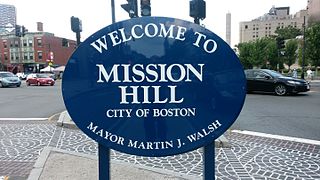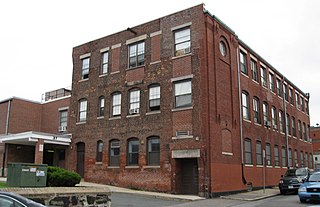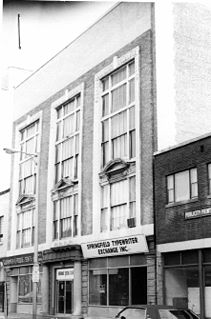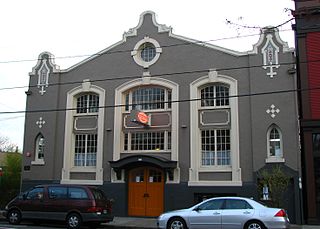
The Boston Public Library is a municipal public library system in Boston, Massachusetts, United States, founded in 1848. The Boston Public Library is also the Library for the Commonwealth of the Commonwealth of Massachusetts; all adult residents of the commonwealth are entitled to borrowing and research privileges, and the library receives state funding. The Boston Public Library contains approximately 24 million volumes, and electronic resources, making it the third-largest public library in the United States behind only the Library of Congress and the New York Public Library. In fiscal year 2014, the library held over 10,000 programs, all free to the public, and lent 3.7 million materials.

Roxbury is a dissolved municipality and a currently officially recognized neighborhood of Boston, Massachusetts.

Symphony Hall is a concert hall located at 301 Massachusetts Avenue in Boston, Massachusetts. Designed by McKim, Mead and White, it was built in 1900 for the Boston Symphony Orchestra, which continues to make the hall its home. The hall was designated a U.S. National Historic Landmark in 1999 and is a pending Boston Landmark. It was then noted that "Symphony Hall remains, acoustically, among the top three concert halls in the world ... and is considered the finest in the United States." Symphony Hall, located one block from Berklee College of Music to the north and one block from the New England Conservatory to the south, also serves as home to the Boston Pops Orchestra as well as the site of many concerts of the Handel and Haydn Society.

Mission Hill is a ¾ square mile neighborhood of Boston. The population was estimated at 15,883 in 2011. About 3,000 short-term residents are undergraduates from neighboring colleges, and maybe another 1500 are short-term visiting scholars, students, researchers, and degree candidates working in the adjacent Longwood Medical Area for Harvard Medical School, Harvard T.H. Chan School of Public Health, and/or the Harvard teaching hospitals.

St. Joseph Catholic Church was a parish in the Roman Catholic Archdiocese of Boston, serving the Roxbury neighborhood of Boston, Massachusetts, USA. The parish was established in 1845, and a church was built in the same year. The entire church complex, including the rectory, convent and parish school, was added to the National Register of Historic Places in 1989. The parish was closed by the archdiocese in 2002, after which the property was sold.

The Berger Factory is a historic factory building at 37 Williams Street in Boston, Massachusetts. Built in 1902, it was home to one of the nation's first manufacturers of precision engineering and surveying instruments, and a surviving example of Roxbury's late 19th-century industrial development. It was listed on the National Register of Historic Places in 1980, and now houses residences.

The Dearborn School is an historic school building at 25 Ambrose Street in the Roxbury neighborhood of Boston, Massachusetts. The three-story brick Beaux Arts school was designed by Roxbury native Edwin James Lewis, Jr., and built in 1905. It is the only building to survive a c. 1950 urban redevelopment of the area. It was named in honor of Boston mayor Henry A. S. Dearborn. It served as an elementary or middle school until the 1980s, and has since been converted into housing.

The Dillaway School is an historic school at 16-20 Kenilworth Street in Boston, Massachusetts. The school was built in 1882 to a design by George Albert Clough, the city's first official architect, and is his only surviving school design in the city. The building was listed on the National Register of Historic Places in 1980, and included in the Roxbury Highlands Historic District in 1989. The building has been converted to residential use.

Dudley Station Historic District is a historic district on Washington, Warren, and Dudley Streets in the Roxbury neighborhood of Boston, Massachusetts, USA. The central feature of the district is the Dudley Square MBTA station, a Beaux Arts/French Renaissance structure designed by Alexander Wadsworth Longfellow and built by the Boston Elevated Railway in 1901. It is one of the best-preserved BERy stations remaining.

The Lower Roxbury Historic District is a historic district encompassing an isolated pocket of 1890s mixed residential-commercial property in the lower Roxbury neighborhood of Boston, Massachusetts. Bounded by Tremont, Columbus, and Burke Streets and St. Cyprian's Place, the area contains a well-kept collection of architect designed buildings that survived late 20th-century urban redevelopment. The district was added to the National Register of Historic Places in 1994.

Roughan Hall is a historic commercial building at 10 City Square, the historic central square of the Charlestown neighborhood of Boston, Massachusetts. Built in 1892 and enlarged in 1896, it is the square's only surviving 19th-century commercial building, and a distinctive example of Romanesque and Renaissance Revival architecture. Its upper levels now serve as the headquarters of the Appalachian Mountain Club. The building was listed on the National Register of Historic Places in 1982.

Roxbury High Fort is a historic fort site on Beech Glen Street at Fort Avenue in the Roxbury neighborhood of Boston, Massachusetts. The site now contains a small park and the Cochituate Standpipe, also known as Fort Hill Tower, built in 1869. The fort site was added to the National Register of Historic Places in 1973. The site inspired the name of the Fort Hill neighborhood which surrounds the area of the High Fort.

The Trinity Neighborhood House is a historic brick townhouse at 406 Meridian Street located in the Eagle Hill section of East Boston, Massachusetts.

Abbotsford, now the Museum of the National Center of Afro-American Artists, is a historic house at 300 Walnut Avenue in Boston, Massachusetts, USA. The museum is dedicated to black visual arts heritage worldwide, and presents historical and contemporary exhibitions in many media, including painting, sculpture, graphics, photography and decorative arts. The museum is operated by the National Center of Afro-American Artists.

The Hibernian Block was a historic commercial building at 345-349 Worthington Street in downtown Springfield, Massachusetts. Built in 1910, it was a distinctive example of Classical Revival architecture, used for many years by a variety of fraternal social organizations. The building was listed on the National Register of Historic Places in 1983, and it was demolished sometime thereafter.

Brookline Village is one of the major commercial and retail centers of the town of Brookline, Massachusetts. Located just north of Massachusetts Route 9 and west of the Muddy River, it is the historic center of the town and includes its major civic buildings, including town hall and the public library. The commercial spine of the village, extending along Washington Street from Route 9 to the library, is a historic district listed on the National Register of Historic Places as the Brookline Village Commercial District.

The Wonder Ballroom is a music venue located in northeast Portland, Oregon. Prior to opening in 2004, the building was occupied by the Ancient Order of Hibernians, the Catholic Youth Organization, the Portland Boxing School, the American Legion Organization, and a community center eventually known as the Collins Center. In 2005, the building was listed on the National Register of Historic Places as the Hibernian Hall for its "historic and architectural significance".

The Ancient Order of Hibernians Hall, also known as Hibernian Hall, was a historic building in Anaconda, Montana, United States, that is listed on the National Register of Historic Places.

Fort Hill is a 0.4 square mile neighborhood and historic district of Roxbury, in Boston, Massachusetts. The approximate boundaries of Fort Hill are Malcolm X Boulevard on the north, Washington Street on the southeast, and Columbus Avenue on the southwest.

The Governor Shirley Square Historic District encompasses a cluster of civic, residential, and religious buildings at the junction of Dudley, Hampden, and Dunmore Streets in the Roxbury neighborhood of Boston, Massachusetts. Named for colonial governor William Shirley in 1913, the square was developed in the 1870s and 1880s as a major locus of civic development after the city of Roxbury was annexed to Boston in 1868. The district was listed on the National Register of Historic Places in 2016.


























